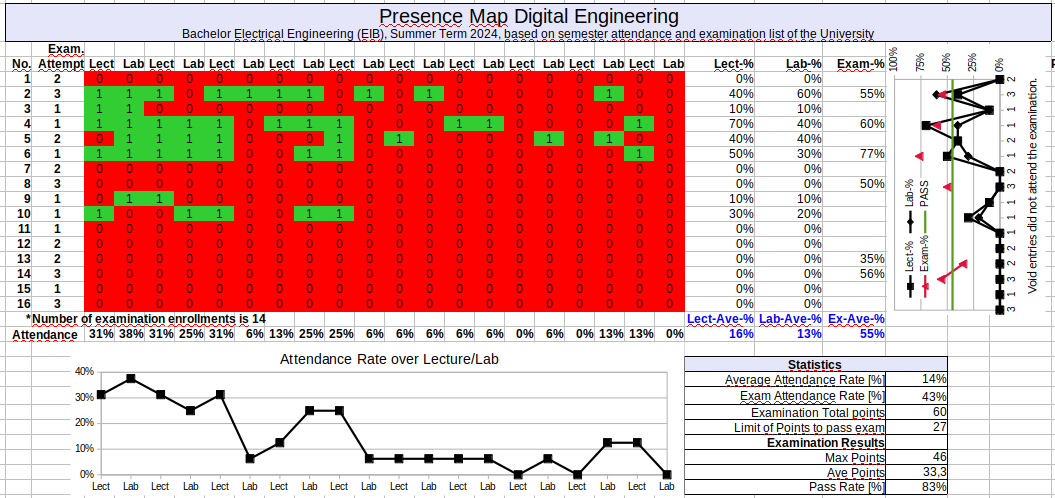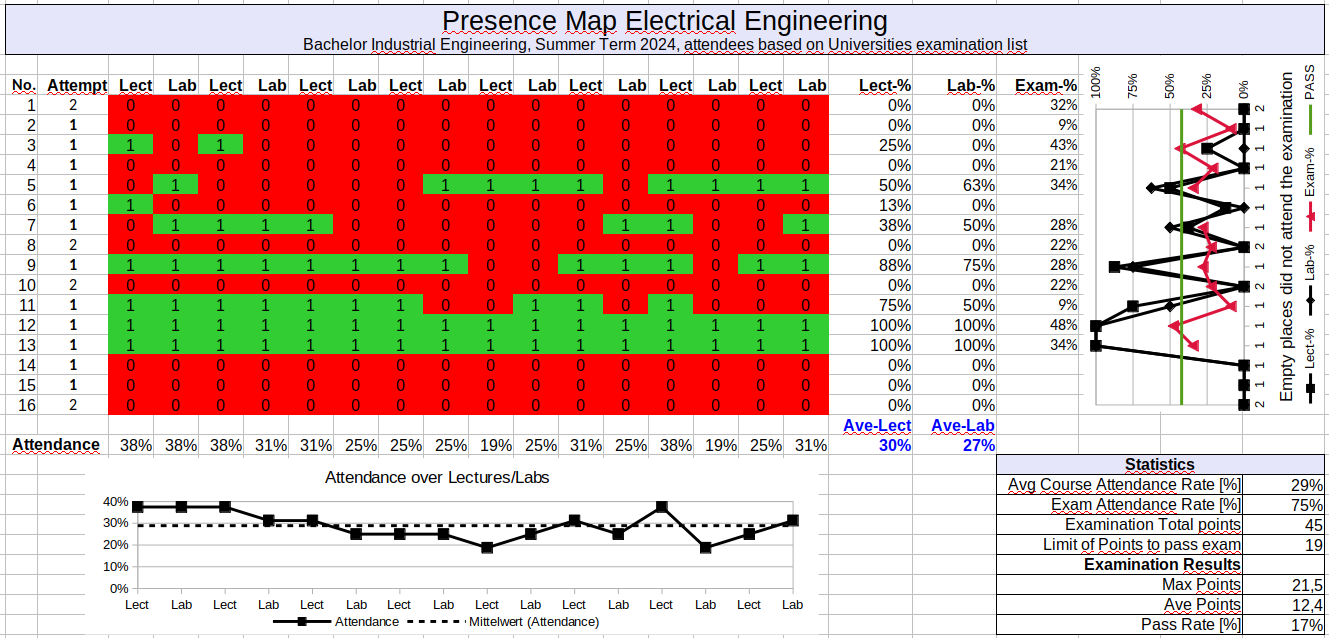The faculty does not apply entrance tests for examinations in general so that all students of the course are eligible examination candidates by definition. Students' attendance discipline or work performance are usually not measured by the faculty. The quality management for my courses relies on individual attendance documentation and correlation to examination results to analyze input-output performance. The examination office of the university builds the examination lists for all registered students of a branch of study.
The examinations are carried out in digital form so that no prints and no travel is required. Attendance is possible from the university campus or from home offices. A monitoring of students during the examination is performed by camera and/or microphone in alignment with the legal regulations. Students are allowed to use the entire course material during the examinations. The online-examinations are as such barrier-free.
The numbers presented below might appear inconsistent because of "unknown" or de-registered students. "Unknown" students are individuals that seemingly exist only on paper (indicated "NV" in the diagrams below). While listed on the official examinations lists they never appear in lectures, exercises, labs or examinations nor do they register on course pages or respond to contacting. This is usually a considerable amount of persons as shown in the course attendance diagnostics. De-registered students are individuals that officially cancel their examination attendance between the finalization of the examination lists and the date of examination.
There is in general some uncertainty in the presence statistics because some students might don't want their presence to be tracked and therefore attend in groups from the university campus.
1. Digital Engineering [w3] - Summary
The course content is structured in modules delivered by scripts and exercises, sample solutions for exercises, lecture videos (MP4), exercise notes from meetings (PDF files), simulations of simple digital circuits and follow-up discussion.
The minimum rate of points to pass the examination is 45%, i.e. 27 out of 60 points. Grades greater than 4 do not pass the examination.
| Distribution Of Points |
 |
| Digital Engineering - Overview Of Grades (1 - Best Grade, 4 - Minimimum Grade to Pass) |
 |
| Digital Engineering - Simulated Pass Rate |
 |
The simulation of the examination pass rate is performed by variations of the minimum rate to pass. The curves are a footprint of the collective knowledge of a course. This makes examination results and the collective students knowledge comparable over semesters. The course content is always the same while the Inverted Classroom teaching method was applied the first time during winter term 2023.
Example (grey dashed line):
if 50% would have been the minimum rate of points to pass, 38% would have passed in the winter term 2019 (last pre-corona semester).
1. comparison (red dashed line): with the same rate of points to pass, 26% would have passed in the summer term 2020 (first corona semester).
2. comparison (green dashed line): with the same rate of points to pass, 71% would have passed in the summer term 2022 (last corona semester).
3. comparison (not shown here): with the same rate of points to pass, 39% would have passed in the winter term 2022 (first post-corona semester).
4. comparison (blue solid line): with the same rate of points to pass, 35% would have passed in the summer term 2023 (second post-corona semester).
5. comparison (black lines): with the inverted classroom teaching method, pass rates of all semesters increased to 50-60%.
The course of curve and the comparison to of semesters allows the assessment of the state of knowledge of the particular courses.
| Digital Engineering |
Enrolled |
Examined |
Attn Rate |
Passed |
Pass Rate |
| 1st attempt |
18 |
8 |
44% |
4 |
50% |
| 2nd attempt |
7 |
3 |
43% |
2 |
66% |
| 3rd attempt |
4 |
3 |
75% |
3 |
100% |
| Total |
29 |
14 |
48% |
9 |
64% |
1.1.1 Regular Examination Digital Engineering - Bachelor Electrical Engineering (EIB)
| Bachelor Electrical Engineering (EIB) |
 |
| Presence map with attendance and examination statistics. |
| Exam EIB (1st Semester) |
Enrolled |
Examined |
Attn Rate |
Passed |
Pass Rate |
| 1st attempt |
5 |
2 |
40% |
2 |
100% |
| 2nd attempt |
5 |
1 |
20% |
0 |
0% |
| 3rd attempt |
4 |
3 |
75% |
3 |
100% |
| Total |
14 |
6 |
43% |
5 |
83% |
1.1.2 Assessment Examination Digital Engineering - Bachelor Electrical Engineering (EIB)
Students in the first semester of the EIB branch of studies are eligible candidates for an assessment examination per examination regulations (SPO).
| Exam EIB (1st Semester) |
Enrolled |
Examined |
Attn Rate |
Passed |
Pass Rate |
| 1st attempt |
0 |
0 |
0% |
0 |
0% |
| 2nd attempt |
5 |
3 |
60% |
0 |
0% |
| 3rd attempt |
1 |
0 |
0% |
0 |
0% |
| Total |
6 |
3 |
50% |
0 |
0% |
1.2 Digital Engineering - Bachelor Intelligent Mobility Systems (IMS)
The course was not offered in the winter term for this branch of study. All candidates prepared themselves in self-study with the available online material, i.e. lecture videos, PDF exercise notes, former examinations with sample solutions.
| Bachelor Intelligent Mobility Systems (IMS) |
 |
| Presence map with attendance and examination statistics. |
| Exam IMS (2nd Semester) |
Enrolled |
Examined |
Attn Rate |
Passed |
Pass Rate |
| 1st attempt |
13 |
6 |
46% |
2 |
33% |
| 2nd attempt |
2 |
2 |
100% |
2 |
100% |
| 3rd attempt |
0 |
0 |
0% |
0 |
0% |
| Total |
15 |
8 |
53% |
4 |
50% |
2. Electrical Engineering [w3]
The course content is structured in modules delivered by scripts and exercises, sample solutions for exercises, lecture videos (MP4), exercise notes from meetings (PDF files), work packages with simulation models and a correlation to the underlying theory (ZIP archives).
The minimum rate of points to pass the examination is 42%, i.e. 19 out of 45 points.
2.1. Electrical Engineering - Summary
| Electrical Engineering (Total) |
Enrolled |
Examined |
Attn Rate |
Passed |
Pass Rate |
| 1st attempt |
36 |
16 |
44% |
5 |
31% |
| 2nd attempt |
21 |
4 |
19% |
2 |
50% |
| 3rd attempt (or higher*) |
8 |
1 |
13% |
0 |
0% |
| Total |
65 |
24 |
37% |
7 |
29% |
*examination attempts for attestations without gradings are UNLIMITED per examination regulations of the faculty Electrical Engineering
| Pass Rate Simulation |
 |
| Simulated Pass Rate over Minimum Rate To Pass. |
2.2 Electrical Engineering - Bachelor Electrical Engineering (EIB)
| Bachelor Electrical Engineering (EIB) |
 |
| Presence map with attendance and examination statistics. |
| Exam EIB (1st Semester) |
Enrolled |
Examined |
Attn Rate |
Passed |
Pass Rate |
| 1st attempt |
7 |
3 |
43% |
1 |
33% |
| 2nd attempt |
7 |
0 |
0% |
0 |
0% |
| 3rd attempt (or higher*) |
6 |
0 |
0% |
0 |
0% |
| Total |
20 |
3 |
15% |
1 |
33% |
*examination attempts for attestations without gradings (called 'Schein') are UNLIMITED as per examination regulations of the faculty Electrical Engineering
2.2 Electrical Engineering - Bachelor Industrial Engineering (EIW)
| Bachelor Industrial Engineering (EIW) |
 |
| Presence map with attendance and examination statistics. |
| Exam EIW (1st Semester) |
Enrolled |
Examined |
Attn Rate |
Passed |
Pass Rate |
| 1st attempt |
12 |
9 |
75% |
2 |
22% |
| 2nd attempt |
4 |
0 |
0% |
0 |
0% |
| 3rd attempt (or higher*) |
0 |
0 |
0% |
0 |
0% |
| Total |
15 |
9 |
60% |
2 |
17% |
*examination attempts for attestations without gradings (called 'Schein') are UNLIMITED as per examination regulations of the faculty Electrical Engineering
2.3 Electrical Engineering - Bachelor Industrial Engineering International (IWI)
| Bachelor Industrial Engineering International (IWI) |
 |
| Presence map with attendance and examination statistics. |
| Exam IWI (1st Semester) |
Enrolled |
Examined |
Attn Rate |
Passed |
Pass Rate |
| 1st attempt |
17 |
4 |
24% |
2 |
50% |
| 2nd attempt |
10 |
4 |
40% |
2 |
50% |
| 3rd attempt (or higher*) |
2 |
1 |
50% |
0 |
0% |
| Total |
29 |
9 |
34% |
4 |
44% |
*examination attempts for attestations without grading (called 'Schein') are UNLIMITED as per examination regulations of the faculty Electrical Engineering
 SS'24 - Print Savings due to Online-Examinations - 1040 Sheets.
SS'24 - Print Savings due to Online-Examinations - 1040 Sheets.
Calculation: 10 sheets per examination (double-sided color prints for German and English versions) in average times registered attendees plus 10 prints for unregistered attendees. Unregistered attendees are allowed to attend the examination as per instruction of the examining board of the faculty. It will be decided later by the examination offices of the faculty, if the attendance was permitted.
Note: Students are registered for examinations by the University automatically and without self-action. The low attendance rates at examinations are the reason for lots of wasted prints. The University sticks to this practice despite several indications with the reasoning that students forget regularly to enroll for examinations. I therefore decided after the Corona pandemic to offer Online-Courses and Online-Examinations to eliminate this waste.
The waste savings due to prints for registered but non-attending students was 660 sheets of paper (i.e. 63,4%). This amount would have been printed and dumped. Students normally (some rare exceptions do exist) do not collect these prints for training purpose as far as I can confirm.









 SS'24 - Print Savings due to Online-Examinations - 1040 Sheets.
SS'24 - Print Savings due to Online-Examinations - 1040 Sheets.